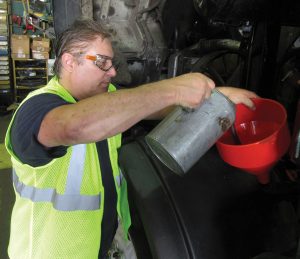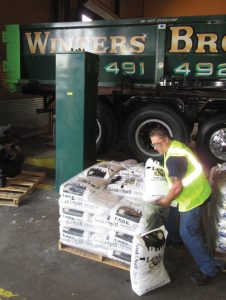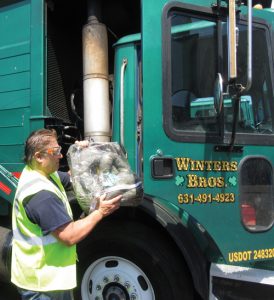It does not matter where you work, transfer station, landfill, recycling center, collection route or in a shop, leaks and spills can occur. When a spill happens, a smart and speedy response is needed to contain and clean up the mess, protect the environment and minimize costs.
The best spill control is prevention. Using proper containers, regularly inspecting liquid storage areas, good housekeeping, inspecting hydraulic hoses and fittings and having adequate secondary containment will help ensure that liquids, hazardous substances, chemicals, oils, fuels, leachate and other liquids are safely stored and not released into the environment. That being said, every facility and hauling operation needs to have a workable Emergency Spill Response Plan that can help guide a response when a spill occurs. The plan can identify the steps that need to be taken in order to keep the spill from entering sewer or storm drains, spreading, affecting human health or entering bodies of water or contaminating groundwater.
Safe Storage
The following are some best practices for storing liquids:
- Have appropriate spill cleanup materials readily available to contain and clean up spills.
- Train employees on the facility’s spill response plan and the location and proper use of clean up tools and supplies.
- Store liquids inside a building or under a cover with adequate secondary containment.
- Use proper signage to identify the contents of containers in accordance with local, state and Federal regulations.
- Provide adequate space around and between containers so that inspections can be easily conducted.
- Inspect containers on a regular basis to make sure that they are in good condition and that there are no leaks.
- Place drip pans or absorbent material beneath taps and at likely spill locations to capture liquids that may escape during the filling and unloading process.
- Protect the liquid storage area from fire and have a supply of the proper fire extinguishers onsite to fight fires.
- Empty containers, including drums, should have all markers and labels removed and the container marked with the word “EMPTY.”
- Take special care when storing flammable materials and properly ground containers of flammable material to prevent static spark.
- Always maintain an adequate amount of headspace in containers to allow for expansion. In 55-gallon drums, provide at least 4 inches of headspace.
- Liquid storage areas should be well lit and kept tidy. The area should be broom swept and cleaned on a weekly basis. Never hose down liquid storage areas as this could result in oils and other chemicals being washed down a drain. All spills, large and small, should be immediately cleaned up.
Employee Training

Photos courtesy of Will Flower.
Employees should receive periodic training on the proper storage and handling of liquids including spill prevention and emergency response procedures to be taken in the event of a spill. As part of the training, employees should review the availability and contents of the Emergency Response Spill Kit to make sure the supplies are available and ready for use in the event of a spill. Emergency Response Spill Kits should be placed in areas where spills are likely to occur.
Spills in the Shop
Inside maintenance and repair shops, most spills take place when oil is being changed, fuel tanks are being removed, radiators are being repaired or when liquids are being transferred. It is a good practice to conduct vehicle maintenance inside or under cover to prevent storm water from mixing with liquids that have been removed from a vehicle. All employees should take extra precautions when handling liquids within the shop area and mechanics should keep their work area clean and tidy at all times and use drip pans to catch liquids. Never leave full drip pans or other open containers lying around where they can be knocked over resulting in a spill. Mechanics should also use funnels to minimize the risk of a spill.
Spills on the Route
Collection trucks typically carry a variety of liquids including fuel, hydraulic oil, motor oil, coolant and diesel exhaust fluid (DEF). Spills from vehicles can occur due to accidents, rollovers, broken hoses and ruptured fittings. Another common spill area is the fueling station. Drivers should be taught and reminded that they should never walk away from truck that is being fueled even if the fueling system has an automatic shut off.
A driver’s pre-trip inspection should include a visual review of tanks, hoses and fittings to identify any leaks. All leaks should be immediately repaired. Additionally, drivers should make sure that the vehicle has an up-to-date spill kit on board to manage spills.
A dry cleanup using adsorbent materials is much better than hosing down the spill area. Make sure the adsorbent materials are swept up and disposed of properly. Bigger spills may require an expanded response especially if the spills are on roadways and other public areas. The Emergency Spill Response Guide should include a list of clean up contractors who are available 24/7 to assist in a cleanup.

Quick Action
When a spill occurs, employees and managers need to act fast to stop the spill and mitigate damage. Follow these basic steps to protect the public health and the environment:
- Protect yourself and others at all times.
- Determine what spilled and use appropriate Personal Protective Equipment including gloves, eye protection, special protective clothing, etc.
- Review Material Safety Data Sheets (MSDS) to determine safe handling and clean up information.
- If it is safe, stop the source of the spill (make sure you have proper protective clothing and equipment to protect workers).
- If the spill has the potential for fire or explosion, remove all potential sources of ignition, evacuate the area and call 9-1-1.
- Control and contain the spill to prevent liquids from leaving the facility. Use absorbent materials. Cover drains and berm areas to prevent liquids from escaping. Remember, liquids flow along a path of least resistance.Clean up the spill using an onsite spill response kit or call for help from clean up contractors.
Notify appropriate agencies if a release has gone offsite or exceeded the Reportable Quantity (RQ). There are specific requirements including timelines for reporting spills that are established by state and federal laws. Permit conditions and local laws may also govern notification. In all cases, it is important to know what type of material and how much was spilled because the RQ sets the threshold for reporting. Federal regulations require that any oil spill into a water body or onto an adjoining shoreline be reported to the National Response Center (NRC) at (800) 424-8802. The National Response Center acts as a clearing house and central reporting point for the release of oil or fuel to surface water, or a release of a chemical with an established Reportable Quantity-RQ.
When reporting a spill, provide the following information:
- Your name and telephone number
- Exact address/location of the spill
- Date, time, cause and type of incident (spill, fire, vehicle accident, etc.)
- Name of material that was spilled
- Quantity of material that was spilled
- Injuries (if any)
- Possible hazards to the public health and/or environment outside of the facility
It is important to identify the liquid(s) that has been spilled so that employees and the cleanup team are aware of the chemical’s hazardous properties. Large spills may require help form third-party contractors who can supply Vac-Trucks and payloaders to assist in the cleanup. All collected material from the spill—liquid and dry material and used PPE—should be placed in appropriate waste containers, sealed, labeled and stored while arrangements are being made for proper disposal.
Everyone’s Responsibility
Many activities in the waste collection and recycling industry have the potential to cause spills. The site manager is responsible for everything that happens at his or her site. Therefore, managers need to make sure that employees are properly trained in responding to spills and equipment, vehicles and liquid storage areas are regularly inspected and repairs are made in a timely manner.
Managers should also require the inspection of contractor’s vehicles and equipment for leaking fluids. If a piece of equipment is leaking, take it out of service and get the leak repaired. Any heavy-duty equipment that is not in use should have drip pans placed underneath to catch any liquids. Excessive liquid in the drip pan is a sign that there is a problem and further inspection of the equipment is needed to determine the source of the leak.
Spill prevention is everyone’s responsibility. Drivers, mechanics, laborers, supervisors and managers at maintenance shops, transfer stations, landfills, recycling centers and collection operations have the responsibility to prevent, inspect for and mitigate spills. An effective Emergency Spill Response Plan will describe spill response procedures and identify the cleanup equipment that is readily available at your location.
Next month’s safety tip will focus on lock-out/tag-out as the fundamental safety precaution whenever you are working with electricity or on vehicles or equipment.
Will Flower is the Vice President of Corporate and Public Affairs at Winters Bros. Waste Systems (Danbury, CT). Will has 33 years of experience in the area of solid waste management and environmental protection. He has held operational and executive leadership positions at the Director’s Office of the Illinois Environmental Protection Agency, Waste Management, Inc., Republic Services. Inc. and Green Stream Recycling.
What’s In Your Spill Response Kit?

Spill response kits need to be readily available and easily accessible. It is a good idea to position spill response kits near the obvious locations for potential spills such as liquid storage areas, loading docks, near hydraulic tanks on balers and in the maintenance/repair shop.
A basic spill kit should include:
- A copy of the facility’s Emergency Spill Response Plan
- A list of emergency contact information including up-to-date phone numbers for key employees, regulatory agencies and first responders
- Personal Protective Equipment including gloves, eye protection, boot covers and protective clothing
- Tools to stop leaks such as non-sparking, adjustable wrenches, wooden plugs and hammers
- Drain covers (usually rubber or clay mats that allow you to quickly seal storm and sewer drains)
- Absorbent socks and pads
- Mop and bucket
- Squeegee
- Shop rags
- Plastic tarps
- Hand tools including brooms and flat-bladed shovels
- Overpack drums (95 gallon drums with locking lids)
The spill response kit should be kept in an easy to reach location and regularly inspected to make sure everything is readily available for use.
Most importantly, employees should receive training and regular refresher training to ensure that they are able to safely and effectively use the contents of the kit when responding to spills.
